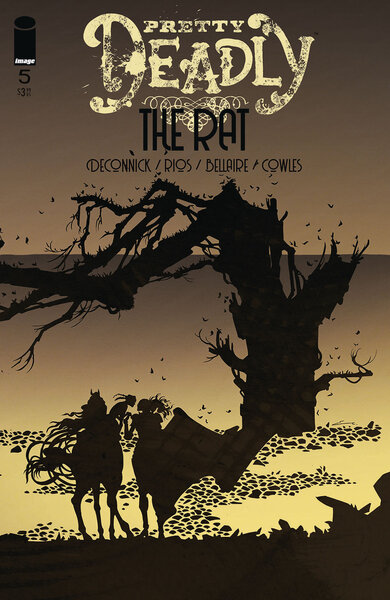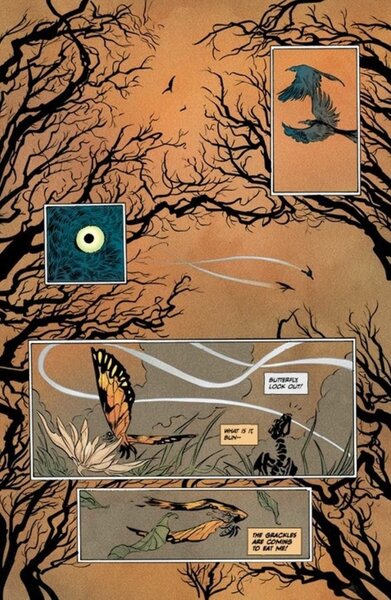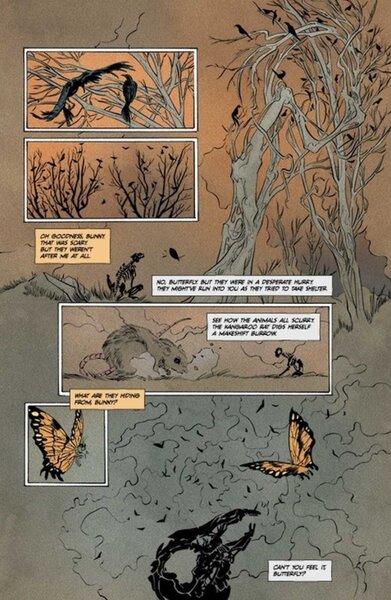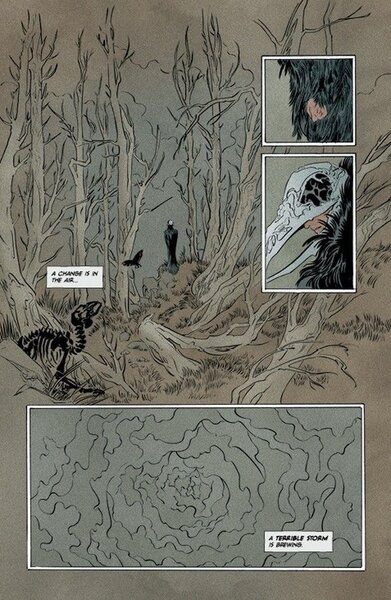Create a free profile to get unlimited access to exclusive videos, sweepstakes, and more!
Indie Comics Spotlight: Kelly Sue DeConnick finds the haunting beauty in death with Pretty Deadly
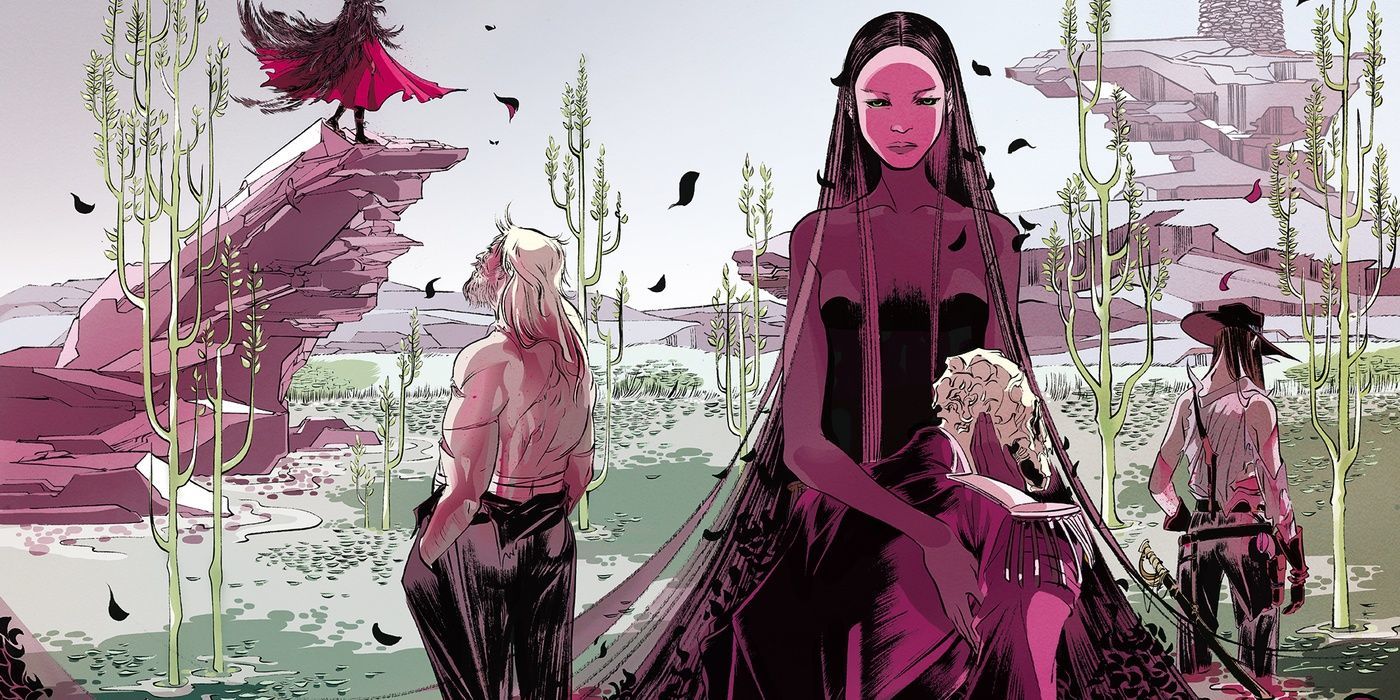
Comics writer Kelly Sue DeConnick has been very busy in the past few years. She took a bit of a break from the award-winning Bitch Planet (which will be returning soon with Issue 11) to pen a brand-new Aquaman series, make a cameo in 2019's hit movie Captain Marvel (the film's Carol Danvers was largely influenced by DeConnick's run starting in 2012), and work alongside fellow writer and spouse Matt Fraction to ink a TV deal with Legendary Pictures through their company Milkfed Criminal Masterminds, Inc.
All the while, the writer, mom, and visionary was quietly working on the gorgeously expansive world of Pretty Deadly with artist Emma Rios, colorist Jordie Bellaire, and letterer Clayton Cowles.
Pretty Deadly is an extended metaphor. It's a "story about stories" that explores the concepts of death, life, and purpose through the eyes of deities and spirits, taking place in a space where time is relative and entire lifetimes can pass by in a few pages.
The story is told in three layers. The immortal realm centers around Death, who is trying to rebuild the World Garden and locate all of the errant Reapers in the process. Then there are the mortals, mainly the lineage of Sarah Fields, the woman who would save an immortal and inadvertently bless (or curse) her family for generations. The third layer follows the remains of a rabbit simply called "Bunny" and a butterfly aptly named "Butterfly," who together provide a frame for Pretty Deadly's lyrical painting. The pair act as a Greek chorus of sorts, providing context and commentary at the start and end of every issue.
The series concludes the third of its scheduled five arcs this week with Issue 5 of Pretty Deadly: The Rat.
SYFY WIRE spoke with Kelly Sue DeConnick to explore the mythos, inspiration, and collaborative process behind the fabled tale.
This story started over 10 years ago, right?
We have been working on this book for a very long time, and the first three pages were written like a year before the rest of it. We used those to get the rest to sell the book to Image Comics and make the rest of it happen. The first image we had was the little girl in the high grass and she comes up with the gun.
And shoots the bunny in the head.
[Laughs] Yeah. Apparently, Emma and I are really into ocular trauma, which was not a conscious choice at all. But [it] now is a thing we laugh about all the time.
There are a lot of animals in this tale ...
All of the animals that appear in all five volumes are all indigenous to North America. It also comments on comic books specifically because that's the medium that we work in. So it goes through major comic book genres.
What are those genres?
The first is the weird western that takes place in the mythology of the American West in the late 1800s. The second is "War" and takes place in the early 1900s. The third arc, "Noir," is in 1930s Hollywood, which is like another kind of American mythology. The fifth arc right now will be a Romance comic and will go back in time to the Vikings in North America. And then the fifth arc we're referring to as a literary comic and will wrap everything up with the Great Depression, which was the sort of first ending of the American myths. This is the first big downswing.
Will all of the stories feature some part of Sarah's family?
Yes. They all have three layers. There are the immortals, which are the Reapers and of course Death. The mortals, which always follow Sarah's family. And Bunny and Butterfly, who are the big frame. The very last thing at the end of Volume 5 will be the end of Bunny and Butterfly's story.
What is the meaning behind the archetypes of the Bunny and the Butterfly?
You know, it's funny. I have zero idea. I don't know where that came from.
The first time I remember saying it out loud I was talking to Brian Michael Bendis about it and I said, "I think the whole thing is a story told from a bunny to a butterfly." I immediately thought that might be too weird. And he said, "Well, now you said it and it's weird and you have to do it."
The volumes are called The Shrike, The Bear, and this third one is The Rat. What do they represent?
Even though she plays a very, very small role in the first volume, it's really Beauty's story. Beauty's daughter helps her, but no one rescues her. She's the one that impales death. The Shrike is an impaling bird. We didn't want to think of her as an object, as something to be, obsessed over and dehumanized. It's really her pain that causes the beginning of all of this.
Then the second volume is named The Bear for Sarah. Even though it's really her son that takes center stage [in that arc]. But again, we wanted to elevate her and all of her mortal progeny. With the third volume, The Rat, we wanted to make it clear that this is Clara's story.
It's a very immersive kind of storytelling.
With Pretty Deadly, the reader is asked to work a little harder than with most comics. We try to lighten that load as much as possible. I kind of love the puzzling-out aspect, but we don't want it to feel like homework. We want it to feel like a fun, exciting puzzle.
Your writing is so lyrical and Emma and Jordie's work is so ethereal, how do you write scripts for this?
There's a line from Steven Universe where there's a character described as a "conversation" because it's two people. This is four or five people, but this book is very much a conversation. It's written scene by scene. I script for Emma mostly in a kind of modified plot style. So I will write what happens in prose with dialogue interspersed, right? Then I will suggest where the page turns are. Then Emma does pencils and I script the next scene based on those pencils while she's inking.
Well, it works because the art is stunning.
Emma and Jordy are phenomenal and they level up every time. Every time I think they've peaked and that they cannot get better, [they show me] a whole other world we haven't explored yet.
Is this the hardest project you've ever worked on?
I was going to say it's the scariest book I worked on. But I think Bitch Planet might actually be the scariest, but for entirely different reasons. I think as artists, our responsibility is to go where we're not safe. We are supposed to go to the places that scare us.
I have a full back piece tattoo of a Kraken. And it comes from a conversation really early on working on this book when I did not know where I was going. There was this point where I wrote to Emma and I was like, "I'm so sorry that I got you into this and I don't know what I'm doing." She responded, "You always go to your dark place and get depressed and then three days later you rise like the Kraken!"
She showed me that getting lost is part of what you have to do every single time. It's scary but every single time it works out.
How much fun was it coming up with all the different reapers?
Oh, a lot of fun. How they paired up was integral to the DNA of the whole story, you know? That was really, really cool. [For instance,] the Hunger reaper and the Thirst reaper are really fame and addiction.
How does Pretty Deadly relate to your life?
[A scholar] told me, "It reads like someone trying to explain death to a child." And in fact, this whole book had so much to do with my son. In the first volume the story about the hummingbird is one of my favorite stories in all of Pretty Deadly. We chose it specifically because my son had had a dream that he had thrown a rock and hit a hummingbird and he hurt it.
He woke up screaming and crying and so upset and horrified that he'd hurt this thing. Somehow he had hurt this hummingbird and he realized it was going to die. The price of being alive in this world and loving and living is you will hurt. And ... you will hurt someone else.
This story was so much about my trying to figure out how to parent and how to tell this boy about the world in a way that he can understand, but also make it clear that nothing is super simple. That's why the book is very personal for me.
It's a fascinating journey into philosophy and spirituality.
It's really fun to work on because it often feels more like discovering than creating. You know how you need another person to use an Ouija board? Neither one of you is really moving it, but you're moving it somehow. I think that's what this is. This is Emma and I with Clayton and Jordy as well with all of our fingers on this thing. Together we're all kind of asking the same questions, and feeling our way to the answers.
